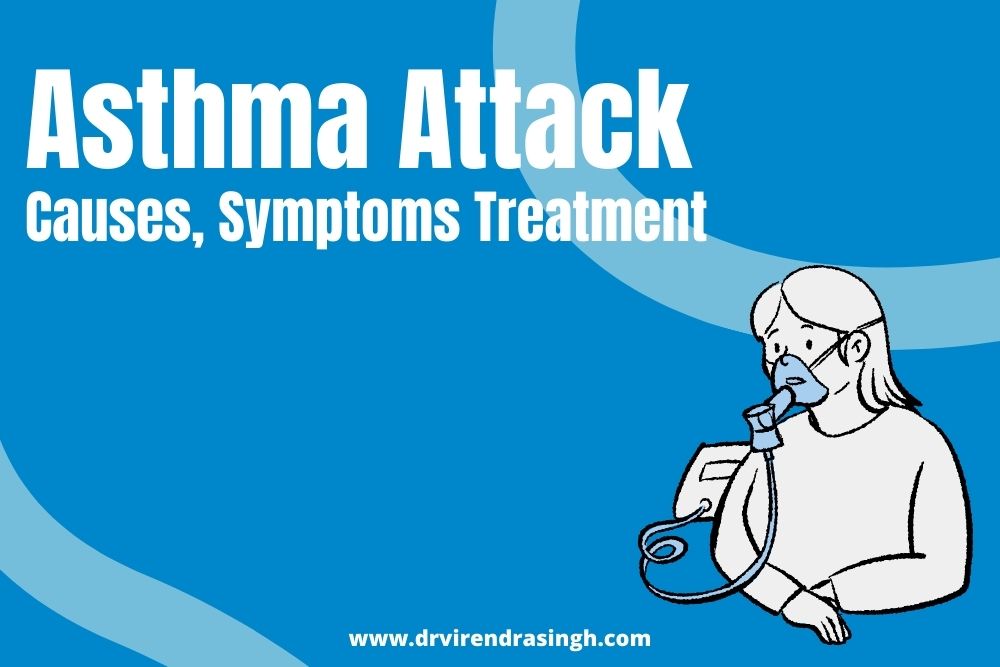
An asthma attack is when your symptoms suddenly get worse because of stiffness in the muscles that surround your airways. Bronchospasm is the medical term for this tightening. During an asthma attack, the lining of the airways swells or becomes irritated, causing the production of more mucus than normal. Breathing difficulties, coughing, wheezing, shortness of breath, and difficulty doing routine everyday activities are all signs of an asthma attack. You might feel like you can’t catch your breath or that it’s getting harder to speak. The inability to breathe during an episode can also create anxiety or panic in some people.
Dr. Virendra Singh explains that an asthma attack begins when your very sensitive airways react to a trigger-like smoke, pollen, dust, cold air, or even stress-by swelling and producing extra mucus. This constricts the airways, which can result in coughing, wheezing while exhaling, and chest pain or tightness. Additionally, you might have trouble breathing deeply, experience dyspnea, and have trouble speaking in complete sentences. Your rescue inhaler may malfunction during a severe attack, peak flow readings may remain low, you may have lightheadedness or confusion, or you may detect a bluish tint around your lips or fingers. Other asthma signs and symptoms can include:
- Chest tightness or pressure
- Severe wheezing when breathing both in and out
- Persistent coughing
- Rapid breathing
- Difficulty talking
- Retractions-tightened neck and chest muscles
- Anxiousness or panic attack
- Blue lips or fingernails
- Pale, sweaty face
- Worsening symptoms despite using medications
Asthma triggers such as exercise or cold air exposure can cause some people with the condition to experience symptoms occasionally after going for extended periods of time without an asthma attack or other symptoms. Mild asthma attacks occur more frequently than severe ones. The airways typically open up in a matter of minutes to hours following treatment. Although they are uncommon, severe asthma attacks last longer and require immediate medical intervention. To help you prevent severe attacks and manage your asthma, it’s critical to identify and treat even the mildest symptoms of an attack.
Early Signs of an Asthma Attack
Early warning symptoms are alterations that take place just prior to or at the onset of an asthma attack. The first indications that your asthma is worsening are these early symptoms, which manifest before the usual asthma symptoms. Early asthma attacks typically don’t generate symptoms severe enough to interfere with everyday activities. However, by being aware of these symptoms, you can prevent or decrease the severity of an asthma attack. Some early indicators of an asthma attack include:
- Reduced peak flow metre readings
- Frequent cough, especially at night
- Exercise-induced asthma manifests as wheezing or coughing during or after physical activity.
- Losing your breath easily or shortness of breath
- Feeling very tired or weak, especially while exercising
- Feeling tired, easily upset, grouchy, or moody
- Runny nose, sneezing, nasal congestion, cough, headache, or sore throat are symptoms of a cold or allergies.
- Trouble sleeping with nighttime asthma
Steps to Carry Out During an Asthma Attack
Here’s how to look after yourself when you have an asthma attack.
1. Give Asthma First Aid
If the person doesn’t have an asthma plan:
- Loosen tight garments and place them comfortably upright.
- Help the person take any asthma medication they may be taking, such as an inhaler.
- Make use of an inhaler from a first aid kit if the patient is without one. A separate drug may be required as rescue treatment, and there is a small chance of infection, so don’t borrow someone else’s.
2. Use an Inhaler with a spacer, if possible
- Remove the cap and shake the inhaler well
- Press the inhaler once to deliver a puff
- Insert the inhaler into the spacer
- Request that they firmly seal their mouth around the spacer mouthpiece and release all of their air.
- Give two puffs in total, with a minute or so between each one.
- Ask them to take a slow, deep breath through their mouth and hold it for ten seconds.
3. Using an Inhaler without a Spacer
- Remove the inhaler cap and shake well
- Make sure the person completely exhales and presses their lips shut around the inhaler mouthpiece.
- When the user starts to breathe in slowly, press the inhaler once.
- The individual should hold their breath for ten seconds after continuing to breathe in as slowly and deeply as they can for five to seven seconds.
- Take two puffs in total, with a one-minute interval between each one.
4. Continue using the inhaler if breathing is still difficult
- Four puffs later, wait four minutes. Give them four more puffs if they are still having difficulty breathing.
- If there is still little to no improvement, give four to eight puffs every 20 minutes for up to four hours, or until the ambulance comes. Four to eight puffs as needed every one to four hours is the recommended dosage if, after four hours, you are still not receiving assistance.
5. Monitor the Person Until Help Arrives
- Sleepiness may indicate that asthma is worsening, so don’t consider it as a sign of progress.
- If you no longer hear wheezing, don’t assume that the person’s asthma is getting better.
6. Follow Up
- A doctor at the emergency room will assess the severity of the attack and administer medication and other forms of therapy.
- The patient’s response to treatment will determine whether they are discharged home or remain in the hospital for more care.
